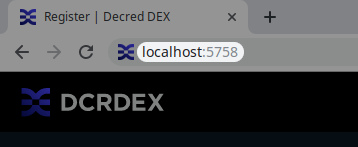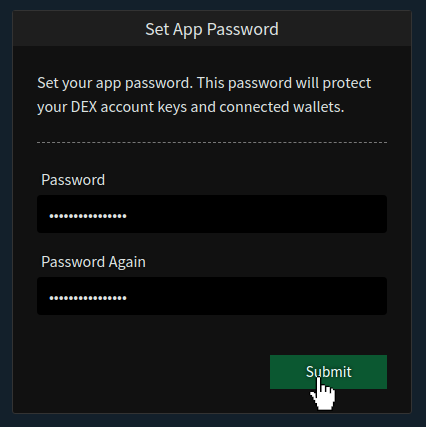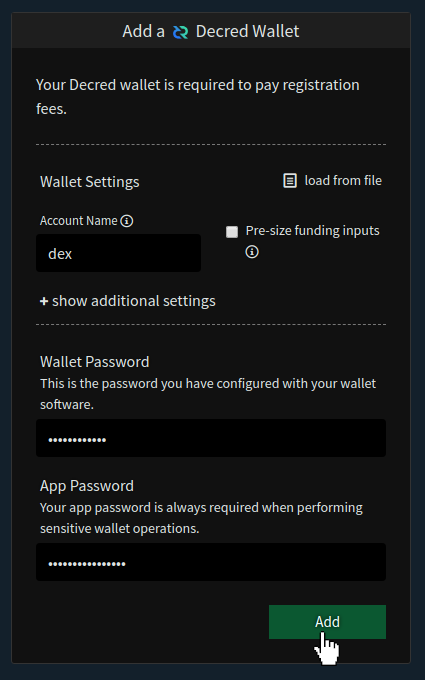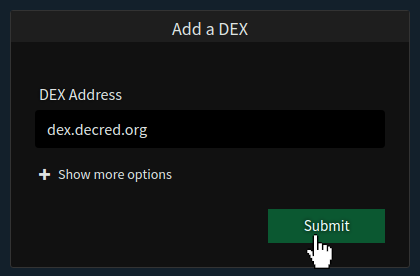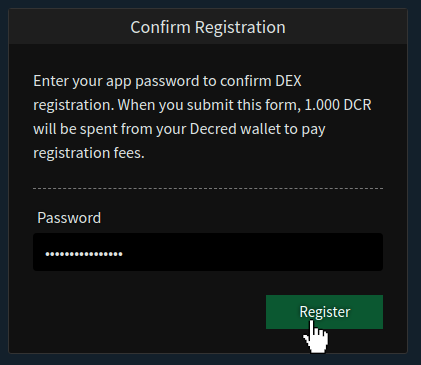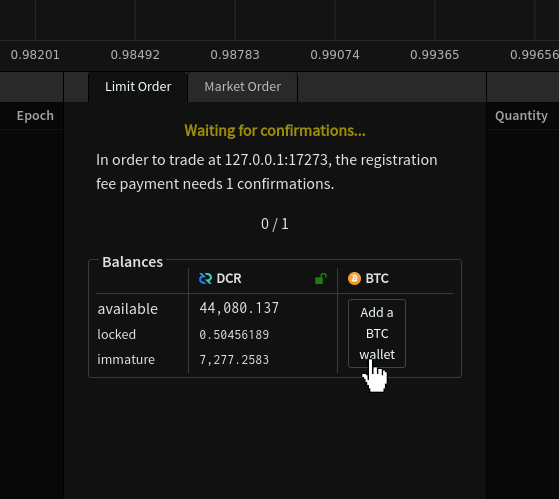What is DEX?
The Decred Decentralized Exchange (DEX) is a system that enables trustless exchange of different types of blockchain assets via a familiar market-based API. DEX is a non-custodial solution for cross-chain exchange based on atomic swap technology. DEX matches trading parties and facilitates price discovery and the communication of swap details.
Matching is performed through a familiar exchange interface, with market and limit orders and an order book. Settlement occurs on-chain. DEX's epoch-based matching algorithm and rules of community conduct ensure that the order book action you see is real and not an army of bots.
Trades are performed directly between users through on-chain contracts with no actual reliance on DEX, though swap details must be reported both as a courtesy and to prove compliance with trading rules. Trades are settled with pure 4-transaction atomic swaps and nothing else. Because DEX collects no trading fees, there's no intermediary token and no fee transactions.
Although trading fees are not collected, DEX does require a one-time registration fee to be paid on-chain. Atomic swap technology secures all trades, but client software must still adhere to a set of policies to ensure orderly settlement of matches. The maximum penalty imposable by DEX is loss of trading privileges and forfeiture of registration fee.
Contents
- Client Quick Start Installation
- Client Configuration
- Important Stuff to Know
- Advanced Client Installation
- DEX Specification
- Client Applications and the Core Package
- Server Installation
- Contribute
Client Quick Start Installation
- It is recommended to have at least 2 GB of available system memory and 25 GB of free disk space to run the DEX client. For the most secure setup, you can also install in a fresh virtual machine.
You can use the dcrinstall tool to install everything you need. dcrinstall will guide you through installation of all needed software and help set up your Decred wallet.
./dcrinstall --dcrdex
dcrinstall will create a directory for your decred binaries.
For Linux and Mac, the directory is at ~/decred. For Windows, it's
%HOMEPATH%\decred. Any commands listed below are assumed be run from this
directory. Instructions are for Linux. For Windows, you will drop the
./ prefix for commands.
WARNING: If instead of using dcrinstall you decide to build from source and
you plan to trade on mainnet, use the release-0.2 branch instead of master.
Furthermore, if you build dcrd and dcrwallet from source, you must use their
release-v1.6 branches, not master.
Sync Blockchains
Once installed, begin syncing your blockchains. In a new console, run
cd ~/decred
./dcrd
Decred should sync within a couple of hours.
In a different console, start syncing Bitcoin.
./bitcoind
The initial Bitcoin sync duration will vary, but more than a day is not atypical. By default, Bitcoin will run with pruning enabled. This will keep your blockchain storage down to a few GB, rather than the 400+ GB required to store the full blockchain. Note that you will download and validate the entire 400+ GB blockchain, but pruning will discard all but the critical parts.
You can modify bitcoin.conf to disable pruning. If this is all gibberish to you, you probably don't need to worry about it.
Important Notes on Wallets
-
If you already have Decrediton installed, upgrade Decrediton before running dcrinstall.
-
The DEX client is not yet compatible with dcrwallet's SPV-mode or CSPP mixed accounts.
-
You must keep dcrd, dcrwallet, and bitcoind running while the client is running. Do not shut down, lock, unlock, or otherwise modify your wallet settings while the client is running.
-
Because of the way fee estimation works, you should give bitcoind at least 6 blocks worth of run time before trading. Failing to allow bitcoind to "warm up" may result in higher transactions fees for your redemption transactions.
Client Configuration
These instructions assume you've used the Client Quick Start Installation. If you've used a custom installation for the client and/or blockchain software, adapt as necessary.
All commands listed below are of the Linux variety, and assume you already
cd into the ~/decred directory created by dcrinstall.
Prerequisites
-
dcrd, dcrwallet, and bitcoind should be running and synced.
-
It is highly recommended that you create separate accounts for trading.
Creating a trading account for Decred
For Decred, start dcrwallet and create an account in your terminal or console using the dcrctl utility.
./dcrctl --wallet createnewaccount dex
Your dex trading account uses the wallet password you've set up with
dcrinstall or ./dcrwallet --create.
Get an address for the new account, and transfer some funds. You'll need to deposit at least enough to cover the registration fee and on-chain fees for the registration transaction. The registration process will inform you how much to pay. At the time of writing, it was 1 DCR. Of course, if you plan to sell any DCR, you should deposit that too.
./dcrctl --wallet getnewaddress dex
Alternatively, you can get a deposit address during registration right after creating your wallet, from the wallets view link at the top right of the screen.
Creating a trading wallet for Bitcoin
For Bitcoin, you can create a trading wallet using the bitcoin-cli utility.
bitcoin-cli will be included in the quick-start installation as well. You
can replace dex with whatever name you want. The rest of the instructions
will assume you chose dex.
./bitcoin-cli createwallet dex
It is recommended that you password-protect your Bitcoin trading wallet.
We'll use read to prevent echoing the password.
read -s BTCPASS
Type your password and hit enter, then do
./bitcoin-cli -rpcwallet=dex encryptwallet $BTCPASS
You'll also want to instruct bitcoind to load the wallet at startup. Modify your bitcoin.conf file, located in the ~/.bitcoin directory on Linux, %APPDATA%\Bitcoin on Windows, and ~/Library/Application Support/Bitcoin on Mac OS. Open the file in a text editor and add the following line at the end of the file.
wallet=dex
Connect Wallets and Register
- Start the client.
./dexc - In your browser, navigate to localhost:5758
- Create your client application password. You will use this password to perform all future security-sensitive client operations, including registering, signing in, and trading.
- Connect to your Decred wallet. The client will auto-fill most of your wallet settings, but you will need to specify the account name. If you haven't already, follow the instructions above to create a trading account. If you really, really want to trade on the default wallet account, the account name is
default. Enter the wallet password, which is the password you set up with dcrwallet. Enter the app password you created in step 3.
- Enter the dex address, probably dex.decred.org.
- Check the registration fee, and enter your password one more time to authorize payment.
- On the markets view, while you're waiting for confirmations on your registration fee, add a Bitcoin wallet. You'll need to specify the wallet name. If you haven't already, follow the instructions above to create a trading wallet. If you really, really want to trade on the default wallet, leave the wallet name blank. Enter the wallet password you set up with bitcoin-cli. If you really, really want to trade on an unencrypted wallet, you can leave the wallet password blank. Enter the app password you created in step 3.
- And that's it! Once your registration fee has enough confirmations, you can begin trading.
Important Stuff to Know
Trades settle on-chain and require block confirmations. Trades do not settle instantly. In some cases, they may take hours to settle. The client software should not be shut down until you are absolutely certain that your trades have settled.
The client has to stay connected for the full duration of trade settlement. Losses of connectivity of a couple minutes are fine, but don't push it. A loss of internet connectivity for more than 20 hours during trade settlement has the potential to result in lost funds. Simply losing your connection to the DEX server does not put funds at risk. You would have to lose connection to an entire blockchain network.
There are initially limits on the amount of ordering you can do. We'll get these limits displayed somewhere soon, but in the meantime, start with some smaller orders to build up your reputation. As you complete orders, your limit will go up.
If your account is suspended, you can appeal the suspension. You may be asked to provide client log files to the operator for review. For dex.decred.org, reach out on Element to appeal.
Advanced Client Installation
Dependencies
- Go >= 1.15
- Node 14+ is used to bundle resources for the browser interface. It's important to note that the DEX client has no external javascript dependencies. The client doesn't import any Node packages. We only use Node to lint and compile our own javascript and css resources.
- dcrd and dcrwallet (non-SPV), installed from the v1.6.x release binaries, or built from the
release-v1.6branch. - Bitcoin Core v0.20.x (bitcoind or bitcoin-qt) wallet, encrypted.
- At least 2 GB of available system memory.
See the wiki for details on preparing the wallets.
Build the web assets from client/webserver/site/.
npm clean-install
npm run build
Build and run the client from client/cmd/dexc.
go build
./dexc --testnet
Connect to the client from your browser at localhost:5758.
While dexc may be run from within the git workspace as described above, the
dexc binary executable generated with go build and the entire site folder
may be copied into a different folder as long as site is in the same directory
as dexc (e.g. /opt/dcrdex/dexc and /opt/dcrdex/site).
Docker
Build the docker image
docker build -t user/dcrdex -f client/Dockerfile .
Create docker volume
docker volume create --name=dcrdex_data
Run image
docker run -d --rm -p 127.0.0.1:5758:5758 -v dcrdex_data:/root/.dexc user/dcrdex
DEX Specification
The DEX specification details the messaging and trading protocols required to use the Market API. Not only is the code in in the decred/dcrdex repository open-source, but the entire protocol is open-source. So anyone can, in principle, write their own client or server based on the specification. Such an endeavor would be ill-advised in these early stages, while the protocols are undergoing constant change.
Client Applications and the Core Package
The initial DEX release also includes the client Core module, written in Go. Core offers an intuitive programmer interface, with methods for creating wallets, registering DEX accounts, viewing markets, and performing trades.
dcrdex has two applications built with Core.
The browser-based GUI (a.k.a. "the app") offers a familiar exchange experience in your browser. The app is really just a one-client web server that you run and connect to on the same machine. The market view allows you to see the market's order book in sorted lists or as a depth chart. You can place your order and monitor it's status in the same market view. The GUI application is managed by the dexc utility in client/cmd/dexc.
The dexcctl utility enables trading via CLI. Commands are parsed and issued to Core for execution. dexcctl also requires dexc.
Server Installation
Dependencies
- Linux or MacOS
- Go >= 1.14
- PostgreSQL 11+, tuned and running.
- Decred (dcrd) and Bitcoin (bitcoind) full nodes, both with
txindexenabled.
Set up the database
In a PostgreSQL psql terminal, run
CREATE USER dcrdex WITH PASSWORD 'dexpass';
CREATE DATABASE dcrdex_testnet OWNER dcrdex;Generate a dcrwallet account public key
The master public key is used for collecting registration fees. Using dcrctl and dcrwallet, create a new account.
dcrctl --wallet --testnet createnewaccount fees
Get the master public key for the account.
dcrctl --wallet --testnet getmasterpubkey fees
Master public keys are network-specific, so make sure to specify the network
to both dcrwallet and dcrctl, if not using mainnet.
Place the pubkey string into a new DEX configuration file.
~/.dcrdex/dcrdex.conf
# Testnet extended pubkey
regfeexpub=tpubVWHTkHRefqHptAnBdNcDJ...
# PostgreSQL Credentials
pgpass=dexpass~/.dcrdex/ is the default app data directory location used by the
DEX server, but can be customized with the --appdata command-line argument.
Run your asset daemons.
As of writing, only dcrd, bitcoind, and litecoind are supported. The
txindex configuration option must be set. Be sure to specify the correct
network if not using mainnet.
Create the assets and market configuration file
A sample is given at sample-markets.json. See the Per-asset Variables section of the specification for more information on individual options.
Build and run dcrdex
From a command prompt, navigate to server/cmd/dcrdex. Build the executable
by running go build. The generated executable will be named dcrdex. Run
./dcrdex --help to see configuration options that can be set either as a
command line argument or in the dcrdex.conf file. The
Exchange Variables section of the specification has
additional information on a few key options.
Run the server.
./dcrdex --testnet
from server/cmd/dcrdex.
Contribute
Looking to contribute? We need your help to make DEX #1.
Nearly all development is done in Go and JavaScript. Work is coordinated through the repo issues, so that's the best place to start. Before beginning work, chat with us in the DEX Development room. The pace of development is pretty fast right now, so you'll be expected to keep your pull requests moving through the review process.
Check out these wiki pages for more information.
- Getting Started Contributing
- Backend Development
- Run dcrdex and dexc on simnet. Recommended for development.
- Run dexc on testnet. Recommended for poking around.
- Run the test app server. Useful for GUI development, or just to try everything out without needing to create wallets or connect to a dcrdex server.
Source
The DEX specification was drafted following stakeholder approval of the specification proposal.
The source code for the DEX server and client are being developed according to the specification. This undertaking was approved via a second DEX development proposal.



